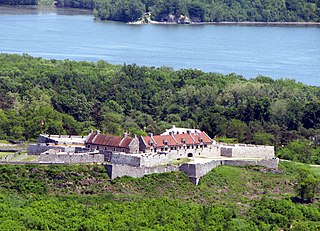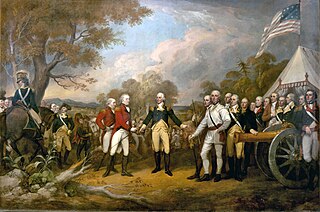
Lake Champlain is a natural freshwater lake in North America. It mostly lies between the US states of New York and Vermont, but also extends north into the Canadian province of Quebec.

Fort Ticonderoga, formerly Fort Carillon, is a large 18th-century star fort built by the French at a narrows near the south end of Lake Champlain, in northern New York, in the United States. It was constructed by Canadian-born French military engineer Michel Chartier de Lotbinière, Marquis de Lotbinière between October 1755 and 1757, during the action in the "North American theater" of the Seven Years' War, often referred to in the US as the French and Indian War. The fort was of strategic importance during the 18th-century colonial conflicts between Great Britain and France, and again played an important role during the Revolutionary War.

The Battle of Valcour Island, also known as the Battle of Valcour Bay, was a naval engagement that took place on October 11, 1776, on Lake Champlain. The main action took place in Valcour Bay, a narrow strait between the New York mainland and Valcour Island. The battle is generally regarded as one of the first naval battles of the American Revolutionary War, and one of the first fought by the United States Navy. Most of the ships in the American fleet under the command of Benedict Arnold were captured or destroyed by a British force under the overall direction of General Guy Carleton. However, the American defense of Lake Champlain stalled British plans to reach the upper Hudson River valley.
USS Enterprise was a Continental Army sloop-of-war that served in Lake Champlain during the American Revolutionary War. She was the first of a long and prestigious line of ships of the United States or by the combatant forces of the U.S. Revolutionary War to bear the name Enterprise.

The Saratoga campaign in 1777 was an attempt by the British high command for North America to gain military control of the strategically important Hudson River valley during the American Revolutionary War. It ended in the surrender of the British army, which historian Edmund Morgan argues, "was a great turning point of the war, because it won for Americans the foreign assistance which was the last element needed for victory."

The Invasion of Quebec was the first major military initiative by the newly formed Continental Army during the American Revolutionary War. The objective of the campaign was to seize the Province of Quebec from Great Britain, and persuade French-speaking Canadiens to join the revolution on the side of the Thirteen Colonies. One expedition left Fort Ticonderoga under Richard Montgomery, besieged and captured Fort St. Johns, and very nearly captured British General Guy Carleton when taking Montreal. The other expedition, under Benedict Arnold, left Cambridge, Massachusetts, and traveled with great difficulty through the wilderness of Maine to Quebec City. The two forces joined there, but they were defeated at the Battle of Quebec in December 1775.

The capture of Fort Ticonderoga occurred during the American Revolutionary War on May 10, 1775, when a small force of Green Mountain Boys led by Ethan Allen and Colonel Benedict Arnold surprised and captured the fort's small British garrison. The cannons and other armaments at Fort Ticonderoga were later transported to Boston by Colonel Henry Knox in the noble train of artillery and used to fortify Dorchester Heights and break the standoff at the siege of Boston.

The 1777 Siege of Fort Ticonderoga occurred between the 2nd and 6 July 1777 at Fort Ticonderoga, near the southern end of Lake Champlain in the state of New York. Lieutenant General John Burgoyne's 8,000-man army occupied high ground above the fort, and nearly surrounded the defenses. These movements precipitated the occupying Continental Army, an under-strength force of 3,000 under the command of General Arthur St. Clair, to withdraw from Ticonderoga and the surrounding defenses. Some gunfire was exchanged, and there were some casualties, but there was no formal siege and no pitched battle. Burgoyne's army occupied Fort Ticonderoga and Mount Independence, the extensive fortifications on the Vermont side of the lake, without opposition on 6 July. Advance units pursued the retreating Americans.

Major-General William Phillips was a British Army officer who served in the Royal Artillery during the American War of Independence.
The USS Liberty was a schooner built at Skenesboro, New York, on Lake Champlain, for wealthy landowner and former British Army Captain Philip Skene. It was captured on 11 May 1775 during a raid on Skenesboro led by Capt. Samuel Herrick, an early action in the American Revolution.
John Brown of Pittsfield, Massachusetts, was a Revolutionary War officer, a state legislator, and a Berkshire County judge. He played key roles in the conquest of Fort Ticonderoga at the start of the war, during the American invasion of Canada in 1775-1776, and once again in 1777 during Lieutenant General John Burgoyne's invasion of the United States by way of Lake Champlain and the Hudson River.

Mount Independence on Lake Champlain in Orwell, Vermont, was the site of extensive fortifications built during the American Revolutionary War by the American army to stop a British invasion. Construction began in July 1776, following the American defeat in Canada, and continued through the winter and spring of 1777. After the American retreat on July 5 and 6, 1777, British and Hessian troops occupied Mount Independence until November 1777.

USS Philadelphia is a gunboat of the Continental Navy. She was constructed from July–August 1776 for service during the American Revolutionary War. Manned by Continental Army soldiers, she was part of a fleet under the command of General Benedict Arnold that fought against the British Royal Navy in the Battle of Valcour Island on Lake Champlain. Philadelphia was sunk during the battle on 11 October 1776.

Valcour Bay is actually a strait or sound, located between Valcour Island and the west side of Lake Champlain, four miles south of Plattsburgh, New York. It was the site of the Battle of Valcour Island during the American Revolutionary War. It was declared a National Historic Landmark in 1961 because of this association. Valcour Bay is located in the Towns of Peru and Plattsburgh, both in Clinton County, New York.
USS Providence, a gundalow, was built at Skenesboro, New York, on Lake Champlain by the Continental Army for Brigadier-General Benedict Arnold's fleet on Lake Champlain in 1776, during the American Revolutionary War.
USS Spitfire was an American gundalow that operated as a gunboat in 1776 on Lake Champlain. She was part of Benedict Arnold's small, hastily built fleet of ships whose purpose was to counter any British invasion forces passing through the lake from Canada. Her service life was brief; after only a few months patrolling the lake she was lost in the aftermath of the Battle of Valcour Island. The gunboat's wreck was located and documented in the 1990s by the Lake Champlain Maritime Museum.

The military career of Benedict Arnold in 1775 and 1776 covers many of the military actions that occurred in the northernmost Thirteen Colonies early in the American Revolutionary War. Arnold began the war as a captain in Connecticut's militia, a position to which he was elected in March 1775. Following the outbreak of hostilities at Lexington and Concord the following month, his company marched northeast to assist in the siege of Boston that followed. Arnold proposed to the Massachusetts Committee of Safety an action to seize Fort Ticonderoga in New York, which he knew was poorly defended. They issued a colonel's commission to him on May 3, 1775, and he immediately rode off to the west, where he arrived at Castleton in the disputed New Hampshire Grants in time to participate with Ethan Allen and his men in the capture of Fort Ticonderoga. He followed up that action with a bold raid on Fort Saint-Jean on the Richelieu River north of Lake Champlain. He then resigned his Massachusetts commission after a command dispute with the head of a detachment of Connecticut militia troops that arrived in June to reinforce Ticonderoga.
New York (1776) was a gunboat built in 1776 at Skenesboro, New York. It was originally called Success prior to launch for service in General Benedict Arnold's fleet on Lake Champlain. New York may be named after the City of New York, because other ships in the fleet were named after cities, however, it could be named after the State of New York, because at least one or two other ships, Connecticut and Jersey, sometimes referred to as New Jersey, were named after states.

Royal Savage was a two-masted schooner built by the British in the summer of 1775. She was damaged and sunk by soldiers of the United Colonies during the Siege of Fort St. Jean and later raised and repaired after the fort was captured. She then participated in General Benedict Arnold's campaign on Lake Champlain. The British captured and burnt her in October 1776 at Valcour Island.
The first USS Trumbull was a row galley built in 1776 at Skenesboro, New York, for service in General Benedict Arnold's fleet on Lake Champlain. She was launched on 10 September 1776 and began active service soon thereafter, Capt. Seth Warner in command.










